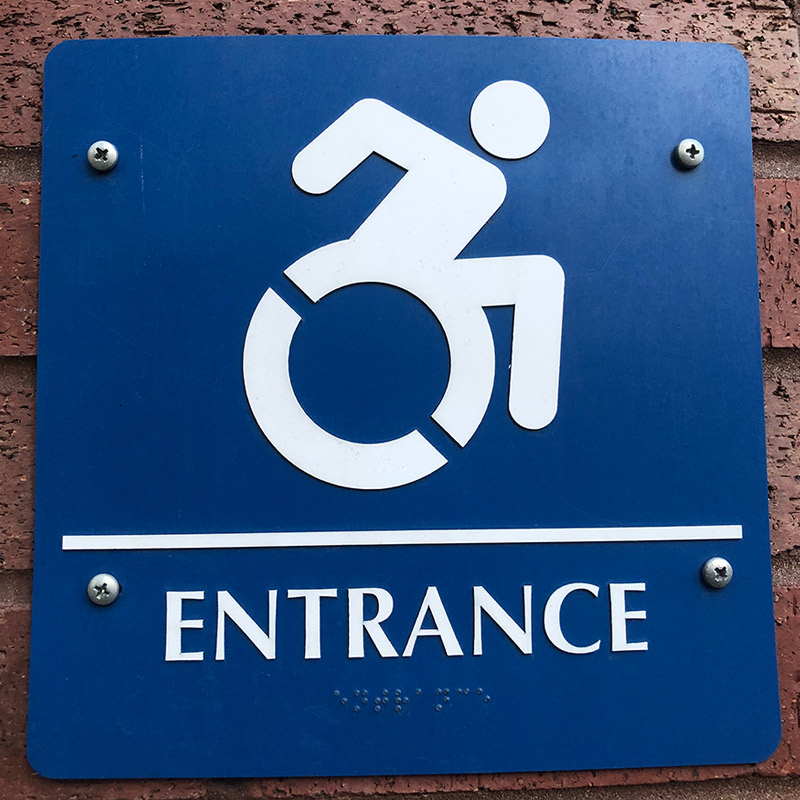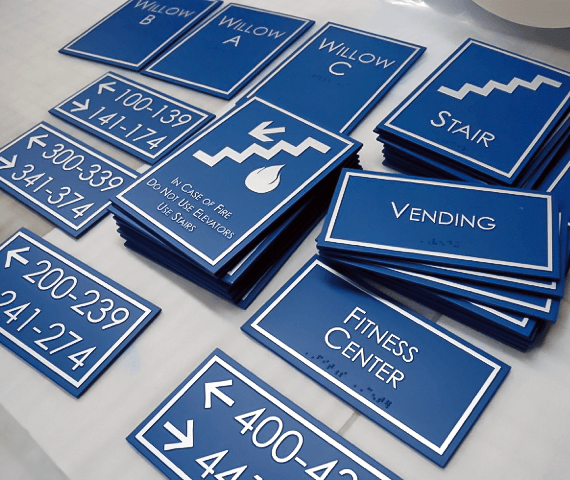The Advantages of Using Top Quality ADA Signs in Your Organization
The Advantages of Using Top Quality ADA Signs in Your Organization
Blog Article
Discovering the Trick Attributes of ADA Indicators for Enhanced Availability
In the world of ease of access, ADA indications serve as quiet yet effective allies, making certain that rooms are comprehensive and accessible for people with specials needs. By integrating Braille and tactile aspects, these indicators break barriers for the aesthetically impaired, while high-contrast color design and understandable fonts satisfy varied aesthetic demands. Their tactical positioning is not approximate but instead a calculated effort to assist in seamless navigation. Beyond these features exists a much deeper story regarding the advancement of inclusivity and the recurring commitment to developing equitable areas. What more could these signs symbolize in our pursuit of global ease of access?
Importance of ADA Compliance
Ensuring compliance with the Americans with Disabilities Act (ADA) is essential for promoting inclusivity and equivalent gain access to in public spaces and work environments. The ADA, established in 1990, mandates that all public facilities, employers, and transport services accommodate individuals with specials needs, guaranteeing they appreciate the very same legal rights and possibilities as others. Compliance with ADA criteria not only satisfies lawful commitments but likewise boosts a company's credibility by demonstrating its commitment to diversity and inclusivity.
Among the key aspects of ADA compliance is the implementation of easily accessible signs. ADA signs are designed to ensure that individuals with handicaps can easily navigate through buildings and spaces. These indications need to comply with certain guidelines pertaining to dimension, font style, color contrast, and placement to assure visibility and readability for all. Appropriately carried out ADA signage aids remove obstacles that individuals with specials needs commonly run into, thereby advertising their self-reliance and confidence (ADA Signs).
In addition, sticking to ADA policies can mitigate the threat of lawful consequences and potential penalties. Organizations that fall short to conform with ADA standards may face lawsuits or fines, which can be both damaging and financially challenging to their public picture. Thus, ADA conformity is integral to cultivating an equitable atmosphere for everyone.
Braille and Tactile Aspects
The consolidation of Braille and responsive elements right into ADA signage symbolizes the concepts of availability and inclusivity. These attributes are vital for individuals who are blind or aesthetically impaired, allowing them to navigate public areas with better independence and self-confidence. Braille, a responsive writing system, is important in offering created information in a style that can be conveniently regarded with touch. It is usually positioned below the matching text on signs to ensure that individuals can access the info without visual support.
Responsive components prolong past Braille and include increased characters and symbols. These parts are designed to be discernible by touch, allowing people to identify room numbers, toilets, leaves, and other important areas. The ADA establishes details standards regarding the dimension, spacing, and placement of these tactile components to maximize readability and make sure consistency throughout various settings.

High-Contrast Shade Schemes
High-contrast shade plans play an essential role in boosting the exposure and readability of ADA signs for individuals with visual problems. These schemes are important as they take full advantage of the difference in light reflectance in between text and history, making sure that signs are quickly discernible, even from a distance. The Americans with Disabilities Act (ADA) mandates the usage of specific shade contrasts to accommodate those with limited vision, making it an essential facet of compliance.
The efficiency of high-contrast colors exists in their capacity to stand apart in numerous lighting problems, consisting of dimly lit atmospheres and areas with glare. Commonly, dark text on a light history or light message on a dark background is utilized to attain optimal contrast. For example, black message on a white or yellow history provides a stark aesthetic distinction that assists in quick recognition and understanding.

Legible Fonts and Text Size
When considering the style of ADA signage, the option of understandable typefaces and suitable text size can not website link be overstated. These elements are vital for making certain that signs are easily accessible to people with aesthetic problems. The Americans with Disabilities Act (ADA) mandates that typefaces have to be sans-serif and not italic, oblique, script, highly decorative, or of unusual form. These requirements help guarantee that the text is easily readable from a range which the characters are appreciable to diverse audiences.
The size of the message likewise plays a critical role in accessibility. According to ADA standards, the minimal text elevation need to be 5/8 inch, and it must enhance proportionally with seeing range. This is specifically vital in public rooms where signage demands to be reviewed rapidly and accurately. Uniformity in text dimension contributes to a natural visual experience, visit homepage aiding people in navigating settings effectively.
Moreover, spacing between letters and lines is important to legibility. Ample spacing avoids personalities from showing up crowded, boosting readability. By adhering to these requirements, developers can substantially improve availability, guaranteeing that signs offers its designated objective for all people, regardless of their aesthetic capacities.
Effective Placement Approaches
Strategic placement of ADA signs is necessary for optimizing accessibility and making sure conformity with lawful criteria. Appropriately located signs direct people with handicaps effectively, assisting in navigation in public spaces. Trick considerations include exposure, distance, and height. ADA guidelines stipulate that indications must be mounted at an elevation in between 48 to 60 inches from the ground to guarantee they are within the line of sight for both standing and seated people. This standard height range is essential for inclusivity, enabling wheelchair users and people of differing elevations to gain access to information easily.
Furthermore, signs have to be put adjacent to the latch side of doors to allow simple identification prior to entry. Uniformity in sign positioning throughout a facility improves predictability, reducing complication and boosting general customer experience.

Conclusion
ADA indicators play an important function in advertising ease of access by incorporating functions that resolve the needs of individuals with handicaps. Incorporating Braille and tactile elements guarantees crucial info is obtainable to the visually impaired, while high-contrast color pattern and understandable sans-serif fonts enhance exposure across different illumination problems. Reliable positioning strategies, such as suitable installing elevations and tactical areas, better facilitate navigating. These elements collectively foster an inclusive atmosphere, emphasizing the relevance of ADA conformity in making certain equivalent accessibility for all.
In the world of ease of access, ADA signs serve as quiet yet effective allies, guaranteeing that spaces are inclusive and accessible for people with impairments. The ADA, enacted in 1990, mandates that all public centers, companies, Look At This and transport solutions suit individuals with specials needs, ensuring they take pleasure in the exact same rights and opportunities as others. ADA Signs. ADA indicators are developed to ensure that people with specials needs can quickly browse with areas and buildings. ADA standards state that indicators must be mounted at an elevation between 48 to 60 inches from the ground to guarantee they are within the line of sight for both standing and seated individuals.ADA indications play a vital duty in promoting access by incorporating features that attend to the needs of people with disabilities
Report this page